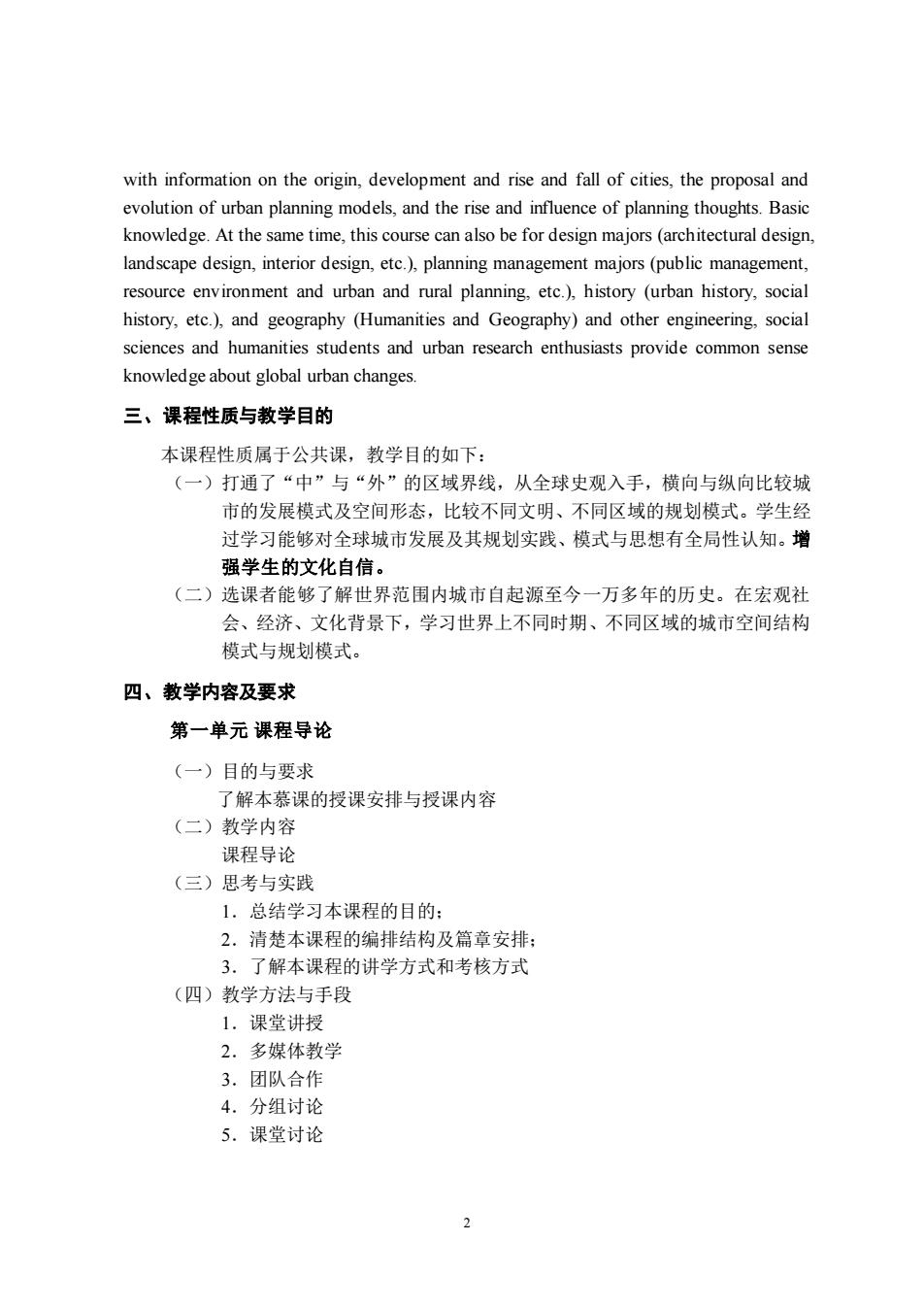正在加载图片...

with information on the origin,development and rise and fall of cities,the proposal and evolution of urban planning models,and the rise and influence of planning thoughts.Basic knowledge.At the same time,this course can also be for design majors (architectural design, landscape design,interior design,etc.),planning management majors(public management resource environment and urban and rural planning.etc.).history (urban history.social history,etc.),and geography (Humanities and Geography)and other engineering,socia sciences and humanities students and urban research enthusiasts provide common sense knowledge about global urban changes. 三、课程性质与教学目的 本课程性质属于公共课,教学目的如下: (一)打通了“中”与“外”的区域界线,从全球史观入手,横向与纵向比较城 市的发展模式及空间形态,比较不同文明、不同区域的规划模式。学生经 过学习能够对全球城市发展及其规划实践、模式与思想有全局性认知。增 强学生的文化自信。 (二)选课者能够了解世界范围内城市自起源至今一万多年的历史。在宏观礼 会、经济、文化背景下,学习世界上不同时期、不同区域的城市空间结构 模式与规划模式。 四、教学内容及要求 第一单元课程导论 (一)目的与要求 了解本慕课的授课安排与授课内容 (二)教学内容 课程导论 (三)思考与实践 1.总结学习本课程的目的: 2.清楚本课程的编排结构及篇章安排 3.了解本课程的讲学方式和考核方式 (四)教学方法与手段 1.课堂讲授 2.多媒体教学 3.团队合作 4.分组讨论 5.课堂讨论 2 2 with information on the origin, development and rise and fall of cities, the proposal and evolution of urban planning models, and the rise and influence of planning thoughts. Basic knowledge. At the same time, this course can also be for design majors (architectural design, landscape design, interior design, etc.), planning management majors (public management, resource environment and urban and rural planning, etc.), history (urban history, social history, etc.), and geography (Humanities and Geography) and other engineering, social sciences and humanities students and urban research enthusiasts provide common sense knowledge about global urban changes. 三、课程性质与教学目的 本课程性质属于公共课,教学目的如下: (一)打通了“中”与“外”的区域界线,从全球史观入手,横向与纵向比较城 市的发展模式及空间形态,比较不同文明、不同区域的规划模式。学生经 过学习能够对全球城市发展及其规划实践、模式与思想有全局性认知。增 强学生的文化自信。 (二)选课者能够了解世界范围内城市自起源至今一万多年的历史。在宏观社 会、经济、文化背景下,学习世界上不同时期、不同区域的城市空间结构 模式与规划模式。 四、教学内容及要求 第一单元 课程导论 (一)目的与要求 了解本慕课的授课安排与授课内容 (二)教学内容 课程导论 (三)思考与实践 1.总结学习本课程的目的; 2.清楚本课程的编排结构及篇章安排; 3.了解本课程的讲学方式和考核方式 (四)教学方法与手段 1.课堂讲授 2.多媒体教学 3.团队合作 4.分组讨论 5.课堂讨论